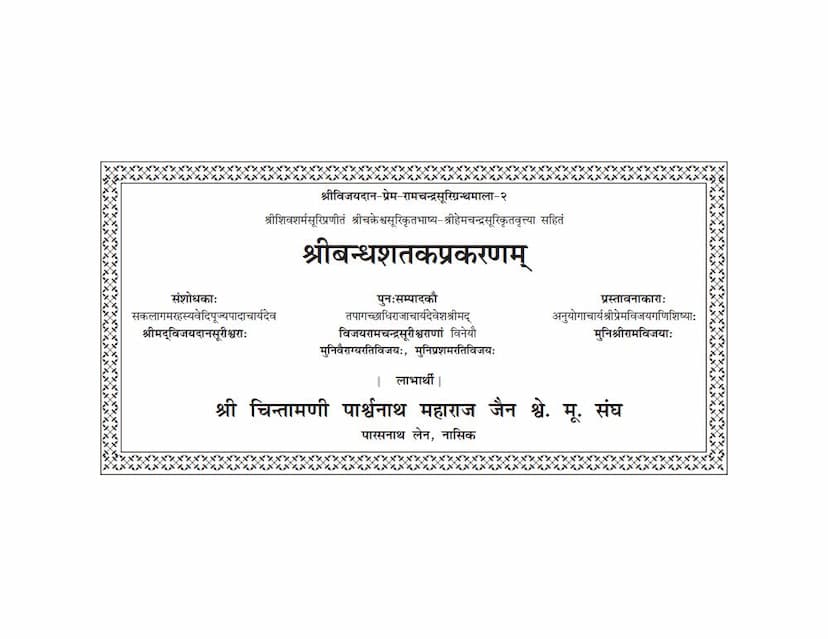Bandhashataka Prakaranam
Added to library: September 1, 2025

Summary
Here is a comprehensive summary of the Jain text "Bandhashataka Prakaranam," based on the provided pages and catalog link:
Title: Bandhashataka Prakaranam (The Hundred Verses on Bondage)
Author: Shiva Sharma Suri
Commentaries:
- Bhashya (commentary) by Chakraeshwar Suri
- Vritti (commentary) by Hemchandra Suri
- Vyakhyana (explanation) by Vijaydan Suri (as editor)
- Prastavana (preface) by Premvijay Gani (written by Muni Ramvijay)
Publisher: Pravachan Prakashan, Pune
Catalog Link: https://jainqq.org/explore/009504/1
Core Subject: The "Bandhashataka Prakaranam" is a foundational Jain text that delves into the intricacies of karma (actions and their consequences) and bandha (the process of karmic bondage). It aims to explain how the soul becomes entangled in the cycle of rebirth (samsara) due to karma and how liberation (moksha) can be achieved.
Key Themes and Content:
-
The Nature of Karma and Bondage: The text emphasizes that karma is the root cause of all suffering (dukkha) and the primary driver of the soul's transmigration through countless lifetimes. It elucidates the nature of karma, describing it in terms of its four main aspects: Prakriti (type of karma), Sthiti (duration of karma), Rasa (intensity or taste of karma), and Pradesha (quantity or extent of karma).
-
Source and Lineage: The book is presented as a condensed and easily understandable work derived from the vast and profound Drishtivada, the twelfth Anga of the Jain Agamas. It specifically draws from the Agrayaniya Purva and the Karma Prakriti Praabhrita within it. The commentaries by renowned Acharyas like Hemchandra Suri and Chakraeshwar Suri highlight its scriptural significance and lineage.
-
Methodology of the Text: Acharya Shiva Sharma Suri composed this "Shataka Prakarana" (hundred-verse treatise) to make the complex subject of karma accessible to those who lack the time, strength, or intellect to study the larger treatises like Karma Prakriti Praabhrita. The text is structured in a way that systematically explains the causal factors of bondage.
-
Structure and Content Breakdown (as per the Index):
- Introduction of Usefulness (Upayoga) and Activity (Yoga): The text begins by defining the soul's consciousness (upayoga) and its various activities (yoga) related to mind, speech, and body. It clarifies the distinction between sakara (with form) and nirakara (without form) upayoga and the different types of yogas.
- Bondage, Manifestation (Udaya), and Eruption (Udhirana): It explains the processes of bondage (bandha), how karma manifests its effects (udaya), and how it can be prematurely brought forth (udirana). The Modaka (sweet ball) analogy is used to illustrate the nature of prakriti bondage.
- Life Forms and Stages (Jiva Sthanas) and Paths of Existence (Marga Sthanas): The text details the fourteen jiva sthanas (states of existence based on sensory organs and consciousness) and analyzes the presence of these jiva sthanas across different paths of existence (hellish, Tiryancha, human, divine) and various marga sthanas (categories of analysis like senses, mind, speech, body, passions, knowledge, restraint, etc.).
- Stages of Spiritual Progress (Guna Sthanas): A significant portion is dedicated to the detailed description of the fourteen guna sthanas (stages of spiritual development) from the viewpoint of karma. It analyzes the application of upayoga and yoga in these stages and the general and specific causes of bondage (bandha hetu) and their manifestation (udaya, udirana).
- Types of Karma and Their Causes: The text systematically explains the causes of bondage for the eight types of karma (ashtakarma) and the 148 original karma categories (mula prakritis).
- Specifics of Bondage Types: It elaborates on prakriti bandha (type of bondage), sthiti bandha (duration), anubhaga bandha (intensity), and pradesha bandha (quantity).
- Ownership of Bondage (Bandha Swamitva): It discusses who is the "owner" or subject to the bondage of specific karmas in different situations and stages.
- General Principles of Karma: The text covers the general principles of alpa-bahutva (lesser-greater) in relation to karma.
- Appendices: The publication includes a Laghu Shataka Bhashya (short commentary), diagrams (yantra), and other supplementary material.
-
Commentaries and Scholarship: The presence of commentaries by Hemchandra Suri and Chakraeshwar Suri signifies the text's importance within the Jain tradition. The preface by Premvijay Gani (Munishri Ramvijay), and the editorial efforts of Viragyarativijay and Prashamrativijay, highlight a dedicated effort to preserve and disseminate this knowledge. The text is rooted in the vast scriptural tradition, tracing its origins to the Drishtivada.
Significance:
The "Bandhashataka Prakaranam" is a crucial text for understanding the Jain perspective on karma, bondage, and the path to liberation. By making complex doctrines accessible, it serves as an invaluable guide for spiritual aspirants seeking to comprehend the causes of their suffering and the methods for achieving freedom from the cycle of rebirth. The commentaries enrich the text, providing layers of interpretation and reinforcing its scriptural validity.